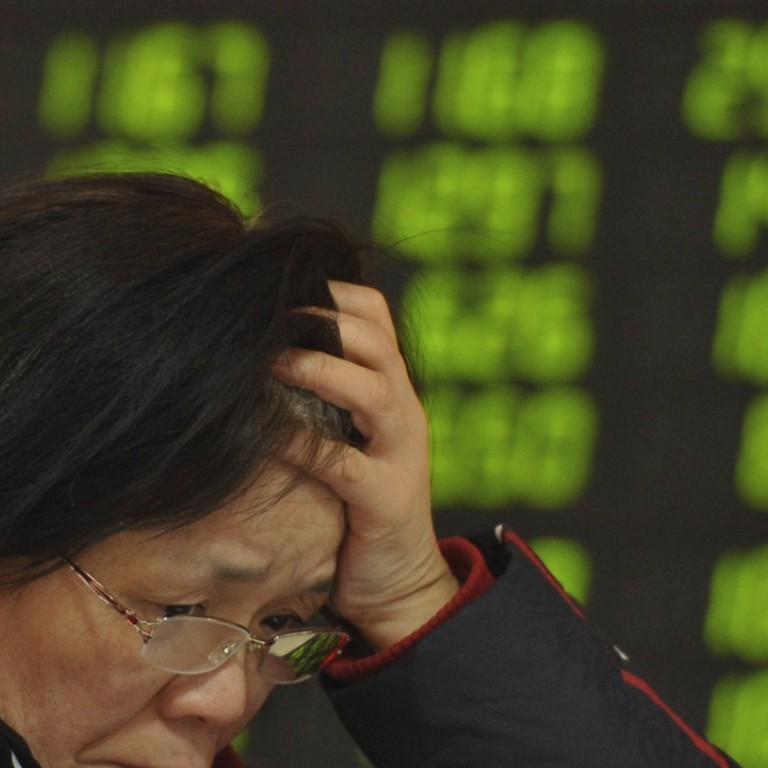
Global markets are plunging from a toxic mix of factors that created the perfect storm for meltdowns
- The OECD has noted that new orders for capital equipment slowed with trade growth, which will show up in corporate earnings
The reason stock markets plunged around the world last week is that greed has now turned to fear, as a toxic combination of over-extended equity valuations, rising interest rates, historically high debt levels, trade and currency wars - and now fear itself - began to feed upon themselves. Such feeding frenzies do not end well.
There is another element in the pernicious cocktail that is often overlooked. Once markets stop rising, they fall - farther and faster than most people expect. This should be as obvious as the law of gravity, but it often isn’t, until it is too late to prevent a crash.
The MSCI Asia-Pacific index has now fallen by 20 per cent from its peak at the end of January, while the US Dow Jones index has given up all its gains this year and Britain’s FTSE 100 hit a seven-month low this week.
The causes of the crash are said to include the clash with Saudi Arabia over journalist Jamal Khashoggi’s cold- blooded murder, the (perennial) Italian crisis and Brexit.
No doubt, Donald Trump will heap all the blame on the US Federal Reserve rather than his own policies.
All of these things set the scene for an inevitable correction in stock prices. But, as with a stone hurled into the sky, the trajectory of stock markets is followed by a fall back to earth after the upwards momentum is spent.
Stock markets do not hang in the air; they fall like a spent rocket. Put another way, they burst like a bubble rather than deflating like a balloon.
To mix metaphors, there may be a dead cat bounce on the way down, as in February this year after a sudden, sharp stocks sell-off, but the cat is still dead for all that.
Even though the equity bull market had grown long in the tooth, running with the bulls can be fun, provided there are others running with you. But when investors start dropping out, that in itself can trigger the very kind of crash that such a strategy is designed to anticipate.
Selling part of a stock portfolio locks in some gains while retaining exposure to any residual upwards momentum. Anyone who invested in 2009 when the bull market began will have gained handsomely by now. If only a few investors adopt such a stealthy strategy the market can absorb it.
But this is not the way things work. Word spreads that some are taking profit on a part of their portfolio. More people will follow. At first, the market adjusts downwards in an orderly way. But this sends a massage that the chase is over.
Few investors buy stocks for the dividends; they buy for capital gains. So, when the thrill of watching paper wealth grow gives way to the prospect of modest gains in share prices rise in line with corporate profits or economic growth, the incentive to hold goes.
More investors then head for the door and prices drop. A stampede for the exit begins and any hope of an orderly retreat is lost as investors rush to protect what remains.
There is little buying on dips at this point although a few vultures may arrive to feed off the bull market carcass. They hope central banks or governments can bail out the market, but this time, there may be little that the authorities can offer by way of financial transfusion.
If monetary stimulus is the blood, then supplies have been exhausted by past interventions while the plasma of fiscal stimulus is low on supplies too.
The problem with the current rout is that it is so broad-based, not only in the number of markets and business sectors hit, but also in the multiplicity of factors feeding the “correction.”
There is no quick fix available to address all or any of these problems.
Rising rates can inflict death by a thousand pinpricks on the ability to service debt. We have not quite reached that point, and corporate distress has not yet become apparent. But it will surface as more debt rollover periods mature.
Governments do not go bankrupt, they tax instead. But given the sheer weight of government debt now, the pincer effect of rising rates and falling tax revenues could be savage, and government bond markets will come under pressure.
But plunging stock prices could be the biggest factor in what Citibank’s former head William Rhodes called the “perfect storm” in markets. Slumping paper wealth directly affects real economic activity in reducing consumption and investment.
The only thing that does seem to hold up is corporate earnings. This cannot continue for long. As the Organisation for Economic Cooperation and Development (OECD) noted, new orders for capital equipment and merchandise have slowed with trade growth.
Once this shows up in corporate earnings, stock prices could suffer even more. At that time, stock prices will accelerate their slide.
This could happen even before trade and currency wars begin to bite. The smell of fear, like greed, is a powerful one for markets.
Anthony Rowley is a veteran journalist specialising in Asian economic and financial affairs

